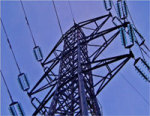 This editorial ran in the Opinion section of Sunday's Santa Fe New Mexican...click here to read it. I wrote it in response to Staci Matlock's article on Tres Amigas from a couple of weeks ago. You may want to read that one first to fully enjoy the satire here! - Mark.
This editorial ran in the Opinion section of Sunday's Santa Fe New Mexican...click here to read it. I wrote it in response to Staci Matlock's article on Tres Amigas from a couple of weeks ago. You may want to read that one first to fully enjoy the satire here! - Mark.
Imagine that you’re sitting on big piles of sunshine and wind and you’re thinking, “Geez, how am I going to get this stuff to market?” when in rides a tall stranger in a Stetson hat. He comes from humble roots – a “ranch kid” from southern New Mexico, and even though he left the state to attend West Point and become a power player in electricity, his firm handshake and his love of western art convince you that he’s still a New Mexican at heart. “The solution,” says the stranger, looking natural in cowboy boots, “will only cost a few billion dollars.”
The tall stranger in this case is Phil Harris, the man being hailed as the “mastermind” of a proposed electric transmission project called Tres Amigas. Harris’ big idea is to build an electric “superstation” that ties together three giant electricity grids so that gigawatts of power can flow between them. This, according to Harris, will “unlock the potential” of New Mexico’s vast renewable energy resources by enabling us to sell sunshine and wind to California.
Does spending a few billion dollars on a system to ship wind and sunshine around the country strike you as odd? I’m pretty sure Californians have sunshine and wind already, but who knows...maybe they would prefer a nice imported brand. Hello...customer service? Do you have anything in a dry, desert wind with hints of pinon and juniper? Great...put it my bill!
The problem with claiming that multi-billion dollar transmission projects like Tres Amigas, Sun Zia, and High-Plains Express are renewable energy projects is that it isn’t even remotely credible. Big transmission lines are for one purpose only: to support big, central power plants like coal and nuclear. And while we continue to invest in obsolete central-power infrastructure, the rest of the world is charging ahead with far more efficient electricity based on distributed power. With distributed power, we wouldn’t need to build any more big, ugly, expensive, inefficient power stations, and we wouldn’t need all these big, ugly, expensive, inefficient transmission lines to haul power over long distances. Instead, independent developers would build lots of small, nifty, clean, efficient power stations, near the loads where they’re needed. This has huge advantages: efficiency goes to the moon, costs go down, reliability improves, and lots of new players come into electricity markets, bringing innovation and private capital with them.
So I don’t think Harris’ superstation is so super after all, and I sure don’t think it has anything to do with renewable energy. No, my guess is that Tres Amigas is a component of a poorly conceived plan to revive the nuclear power industry here in New Mexico. Harris built and ran a nuclear power plant years ago, and this past April he admitted being approached by developers who want to locate nuclear power plants near his project. And why wouldn’t they? We’ve got a nuclear fuels plant going in down in Eunice, New Mexico, and there’s a big push under way to allow our nuclear waste dump in Carlsbad to take high-level waste. All we need is a few reactors and his multi-billion dollar super thingy, and we’re the new, nuke capital of the U.S.
The debate over whether nuclear power is a good idea is a completely separate issue. The question for now is, why are big power-line developers all claiming that their wires are for hauling sunshine? Instead of hints of pinon and juniper, I’m starting to pick up a strong scent of green goo. Whew...check your boots, fellas! And then put ‘em outside where the sunshine can dry ‘em out, assuming you didn’t sell it all to California already.